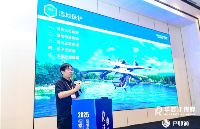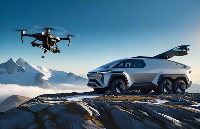Ben Coxworth Review: DJI Phantom quadcopter
Gizmag reviews the DJI Phantom quadcopter
Image Gallery (12 images)
Whether you call it a quadcopter, quadrocopter, quadrotor, UAV or (gasp) a drone, DJI’s new GPS-equipped Phantom is certainly a nifty little radio-controlled aircraft. We first heard about the Phantom when it was officially launched this January and since then I‘ve had a chance to try out the, uh – let’s call it a quadcopter – for myself. Here’s a quick look at my experiences with it, and I’ll say this right now: the thing was more fun than a barrel full of flying monkeys.
Getting it togetherUpon opening the box, I discovered that the Phantom required some basic assembly. I followed along with one of the well-produced instructional videos on the DJI website, though, and it turned out to be pretty straightforward. I also downloaded the Quick Start Manual, just to make sure the video wasn’t leaving anything out.
Those videos – along with the manual, to a lesser extent – also proved invaluable when learning to fly the quadcopter.
Adding an eye in the skyThe Phantom is promoted as being an excellent aerial platform for the GoPro HERO actioncam, and it comes with an adjustable-angle mount designed specifically for the camera. Unfortunately, in order to fit the camera into that mount, you have to remove its protective outer housing. Additionally, that mount doesn’t have room for any of the HERO’s add-on modules, such as the LCD screen or extra battery.
Given that I anticipated making some unavoidably rough landings on the hard, uneven late-winter snow, I decided that my HERO wasn’t about to fly “unclothed.” There is a solution to this dilemma however – the GoPro’s housing can be mounted to the quadcopter in exactly the same way as the provided mount. Whichever method you choose, the camera ends up upside-down, so you’ll either want to enable its video-flipping feature, or flip the footage yourself in editing.
Does anyone here speak Phantom?When it was time for my first flight, I took the quadcopter to a nearby field, turned on its control unit first (as per the instructions), and then turned on the aircraft itself by installing its rechargeable 2200mAh 11.1 V lithium-polymer battery.
The Phantom proceeded to perform a self-check on its systems, and relayed its findings via its single prominent RGB LED indicator – something that it does every time you use it. While the GoPro mount is really just a nit-pick, this method of status display is one of two things that I think could actually stand to be improved.
The LED flashes on and off in various patterns of colors, first of all letting you know that the systems are warming up, and then potentially alerting you to the facts that the Phantom’s compass can’t be calibrated, it can’t find enough GPS satellites, or it’s just too cold. Unfortunately, unless you’ve used the aircraft many times, there’s no way of knowing which of those things these patterns mean, without having a printout or download of the manual close at hand – even then, cross-referencing the rapidly-blinking multiple colors with the written descriptions can be quite challenging. It would be far easier if the controller had a one-line calculator-like LCD screen, that displayed simple text messages like “Wait, initializing” or “Insufficient GPS satt.”
Getting it off the groundI did eventually get it into the air, although I still wasn’t entirely clear on whether or not it was able to access enough satellites for all of its GPS features to work. This was the first time I’d ever flown a remote-control aircraft of any kind, plus it turns out the field I’d chosen wasn’t really big enough, so 。。. well, the rough landings I’d anticipated did indeed happen. Some of them even incorporated a violent descent through tree branches. To the Phantom’s immense credit, though, the only damage it appeared to sustain was a snapped landing strut – not a disabling injury, as it turned out.
The next few times I flew it, I chose a much larger field and ensured that there were enough satellites, plus I was just generally more experienced. It was a blast. Really opening up the throttle, I found that the quadcopter could go fast (10 meters/32.8 feet per second, going forward), it could go high (I don’t know how high, but it looked kind of scary), and it responded to commands instantaneously.
Battery life for all of my flights was about ten minutes, which is right in keeping with DJI’s figures. Although I definitely would have preferred a longer duration, existing battery technology will only take you so far – additionally, the Phantom was lugging my GoPro, and the temperature outside was right around freezing.
Some people might not like the idea of having to pay for its dedicated controller, as the AR Drone (which at US$300 costs a little less than half as much as the $679 Phantom) simply utilizes the user’s smartphone. I found that the two physical joysticks really made controlling the quadcopter intuitive, however, in a way that I doubt touchscreen controls could.
A sense of directionMaking things easier was the option of flying in GPS Attitude mode. This allowed the Phantom to hold its position in mid-air, automatically compensating for wind gusts. Additionally, it kept the quadcopter’s inertia from carrying it forward when coming to stops – as soon as I released the throttle control, the aircraft stopped moving.
The Phantom’s Enhanced Fail-safe feature also made the whole experience less intimidating. If the quadcopter had lost contact with the controller (such as if it had exceeded its 300-meter/984-foot radio range, or the controller’s batteries died), it would have simply flown itself back to its take-off point.
I additionally experimented with its Intelligent Orientation Control, which is a handy feature for newbies like me. Ordinarily, when you want a remote-control aircraft to turn to your left (as an example), you have to first consider which way that aircraft is facing. If its nose is facing away from you, then the aircraft’s left is still your left – if the aircraft is coming towards you, however, then a left turn for it involves its moving to your right. The controls become reversed, which can be very disorienting.
By selecting one of the two Intelligent Orientation Control modes, however, a left turn on the controller will always result in the Phantom moving to your left – regardless of which way its front end is pointing. The same thing goes for right turns, obviously. While this would be impossible with a fixed-wing aircraft, it’s not such a tall order with a multi-directional, symmetrical-bodied quadcopter. It definitely makes those first flights simpler, although it’s probably not a feature you should come to rely on, plus it only works if the aircraft is at least 30 feet (nine meters) away.
Roll the videoViewing the GoPro footage afterwards, I noticed that the vibrations of the Phantom’s motors and/or props caused the video to sort of roll and jiggle. This is something that other users have also complained about, and it’s known as the Jell-O effect. It’s not a deal-breaker for people who just want to watch the footage for fun, but it could definitely be an issue for people who want to use it in a video project.
When I asked DJI about it, I was directed to a YouTube video in which it’s suggested that the camera be set to 60 fps, GPS Attitude mode not be used (the constant adjustments make the quadcopter fly rougher), and the propellers be balanced. It may be good advice, although it involves more tinkering and compromise than some people might like. I‘m wondering if it could have been possible to include a layer of vibration-dampening material between the quadcopter and the camera mount, as a way of keeping the video from resembling a popular jelled dessert.
Of course, if you’re not even interested in shooting video at all, then it’s not a problem.
Summing upI’m still very much getting the hang of the Phantom, and look forward to improving my flying skills. So far, however, things that I’ve liked have included: Tough constructionSimple assemblyBuilt-in GoPro attachment pointGPS-enabled position-holdingIntelligent Orientation ControlPhysical joysticks, as opposed to touchscreen slidersImpressive performance
As for some of the things that could be better 。。.
GoPro mount requires you to take off the camera housingThose enigmatic LED codesJell-O video
A picture’s worth a thousand words, though, so check out my video review below. It contains some rather spectacular crashes, plus you’ll get to see my home-made snow-landing pontoons in action.
Product page: DJI Phantom
自動翻譯僅供參考
DJI Phantom飛行器 本coxworth review:DJI Phantom quadcopter
Gizmag評論DJI Phantom quadcopter
圖像畫廊(12張)
無論你稱它為直升機旋翼無人機,四軸飛行器,,或(喘息)無人機,道瓊斯工業平均指數的新裝備有GPS的幻影肯定是一個漂亮的小無線電控制的飛機。我們第一次聽說幻影何時正式推出今年一月,自那時以來,我試了一下,嗯–讓我們稱它為自己–直升機。這是我的經驗,這一看,我就說如下的話:是不是一個完整的飛猴桶更有趣。
得到它togetherupon打開盒子,我發現幽靈需要一些基本組件。我跟著的一個精心制作的教學視頻,道瓊斯工業平均指數的網站,雖然,它原來是很簡單的。我還下載了快速啟動手冊,以確保視頻沒有留下任何東西。
那些視頻–隨著手動,在較小的程度上–也證明無價的當學飛直升機。
添加天空幻影眼是晉升為成為一名優秀的空中平臺的GoPro英雄actioncam,它帶有一個可調節角度安裝專門設計的相機。不幸的是,為了將相機安裝在這座山上,你必須移除它的保護外殼。此外,這座山沒有任何英雄的附加模塊,如液晶屏幕或額外電池的空間。
鑒于我期待做一些難免粗糙登陸難,不平的晚冬的雪,我決定,我的英雄不會飛的“赤身”。有了解決這一難題,但是–GoPro的房屋可以安裝到直升機完全同樣的方式提供的安裝。不管你選擇哪一種方法,相機都會以上下顛倒的方式結束,所以你會想讓它的視頻翻轉功能,或者自己在編輯中的鏡頭。當它是我的第一次飛行的時間,我把直升機到附近的一個領域,轉向控制單元的第一(按說明書),然后打開飛機本身安裝可充電2200mAh 11.1 V鋰聚合物電池。
幻影繼續執行其系統自檢,并將結果通過單一的突出RGB LED指示燈–東西,它每次使用它。而GoPro坐騎是真的只是一個吹毛求疵,這種狀態顯示方法是一個東西,我覺得其實可以站得到改善。
LED閃爍和關閉各種圖案顏色,首先讓你知道該系統升溫,然后可能會提醒你,幽靈的羅盤無法校準的事實,它找不到足夠的GPS衛星,或太寒冷。不幸的是,除非你用飛機多次,沒有辦法知道那些事情這些模式意味著,沒有在手–甚至有打印或下載手動關閉,交叉引用的快速閃爍的多種顏色與文字說明可以是相當具有挑戰性的。如果控制器有一一線計算器的液晶屏更容易顯示簡單的文本信息,如“等等,初始化”或“不夠GPS時間飽。”
它得到了地終于把它變成空氣,雖然我還沒有對它是否能獲得足夠的衛星對所有的GPS功能的工作完全清楚。這是我第一次坐過的任何一種,遙控飛機,加上原來我選擇的是不是真的足夠大的領域,所以…嗯,我預期的粗著陸確實發生了。他們中的一些人甚至在樹枝上加入了暴力的后裔。對于幻象的巨大的信用,雖然,唯一的損害似乎是一個啪的著陸支柱,而不是一個禁用的傷害,因為它原來。
接下來的幾次我飛,我選擇了一個更大的領域,并確保有足夠的衛星,再加上我只是一般經驗更豐富。那是一次爆炸。真的放開油門,我發現直升機可以快速(10米/ 32.8英尺每秒,前進),它可以高(我不知道有多高,但看起來有點嚇人),它對命令的瞬間。
電池壽命我所有的航班約十分鐘,這符合DJI的數字是正確的。雖然我肯定會有一個持續時間較長,現有的電池技術只會帶你到目前為止–此外,幽靈是拖著我的GoPro,和外面的溫度在冰點。
有些人可能不喜歡這個主意有支付其專用控制器,為AR無人機(這300美元成本一半以上多達679美元的幻影)少一點簡單的利用用戶的智能手機。我發現這兩個物理操縱桿控制直升機真的直覺,但是,在某種程度上,我懷疑觸摸屏控制可以。
有directionmaking事情更容易在GPS姿態模式飛行的選項。這讓幻影在空中保持其位置,自動補償的陣風。此外,它把直升機的慣性推進來停止–我盡快釋放油門控制,飛機停止移動。幽靈的增強的故障安全功能也使整個體驗更不那么嚇人了。如果直升機與控制器失去聯系(如要超過300米/ 984英尺的廣播范圍,或控制器的電池死了),它只會飛回自己的起飛點。
我還嘗試了它的智能化控制,這是像我這樣的新手方便的功能。通常,當你想要一個遙控飛機向左轉(舉個例子),你必須首先考慮的方式是面對飛機。如果它的鼻子是從你的距離,那么飛機的左側仍然是你的左邊,如果飛機是朝你,但是,然后左拐,它涉及到您的權利。控件成為逆轉,這是很令人迷惑。
通過選擇一個智能定位控制模式,然而,控制器上的左轉彎會得到幻影移動到你的左–不管其前端指向。同樣的事情也會進行正確的轉變。這將是一個固定翼飛機是不可能的,這不是一個很高的要求提供多方位、對稱體直升機。這絕對讓那些第一次航班簡單,雖然它可能不是一個功能都要依靠,加上它只能如果飛機至少30英尺(九米)遠。
卷的GoPro視頻觀看錄像之后,我注意到幽靈的電機和/或道具振動引起的視頻類卷和微動。這是其他用戶也抱怨,這是被稱為果凍效應。這不是一個斷路器的人誰只是想看的視頻有趣的鏡頭,但它肯定是一個問題的人誰想要使用它在視頻項目。
當我問DJI呢,我是針對一個YouTube視頻,它的建議,相機被設置為每秒60幀,GPS姿態模式不能使用(不斷調整使直升機飛行),和螺旋槳平衡。這可能是很好的建議,盡管它涉及更多的調整和妥協比一些人可能喜歡。我想知道是否可能包括直升機和攝影機之間有一層減震材料,作為一種保持視頻從類似于流行的膠凍甜點。
當然,如果你不感興趣的拍攝視頻的話,那么它的不是一個問題。
總結UPI是仍然非常得掛魅影,期待提高自己的飛行技巧。
-
無人機
+關注
關注
231文章
10823瀏覽量
186536
發布評論請先 登錄
深謀飛行器總工兼合伙人陳春軒攜「星曜風」產品矩陣 破局低空經濟萬億風口

小馬哥STM32F1主控720空心杯四軸飛行器資料(包含源代碼和相關教程)
Vicor高密度電源模塊助力輕型飛行器設計
小型飛行器專用 AS-DR01模擬信號AI識別跟蹤模塊


天馬供折疊屏!傳音TECNO三折概念機PHANTOM ULTIMATE 2亮相MWC
激光毀傷系統:低空飛行器的 “隱形獵手”
飛行汽車興起,連接器/線纜將面臨哪些挑戰?
大疆震撼發布DJI Flip全能Vlog航拍機
MATLAB在低空飛行器中的應用

大疆發布DJI O4 Air Unit系列:圖傳性能再升級
傳感器在低空經濟中的應用

欣旺達:已具備低空飛行器電池研發生產能力
利用圖像處理板避障 讓小型飛行器像昆蟲一樣靈巧






 DJI Phantom飛行器
DJI Phantom飛行器











評論